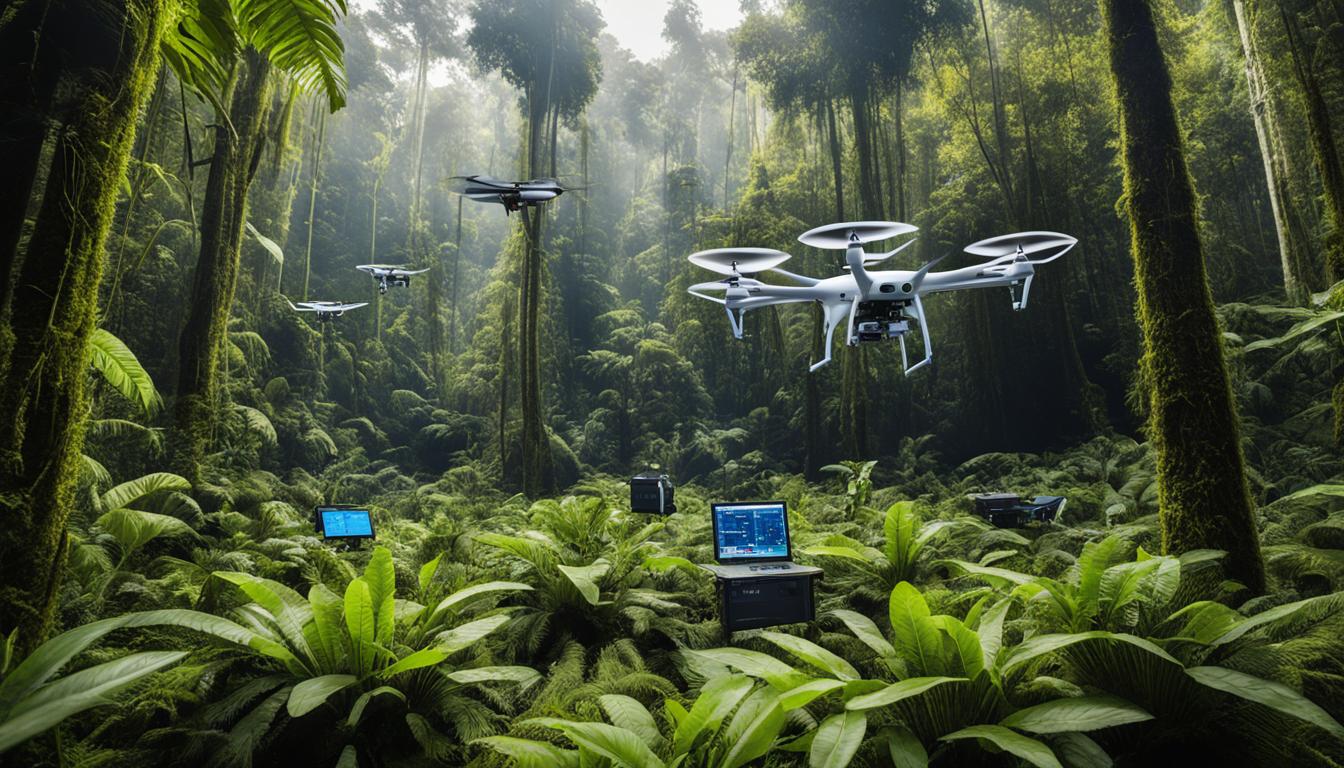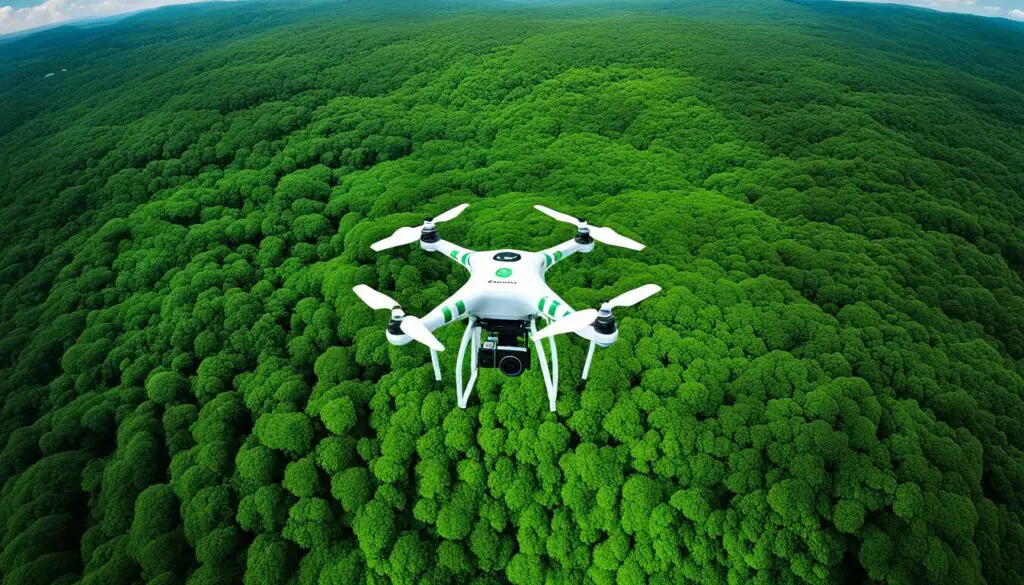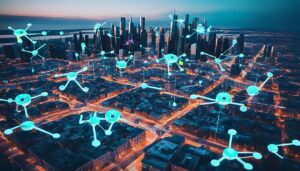
As our planet faces increasing threats to biodiversity, preserving our natural environment has become more crucial than ever. Fortunately, advancements in technology, particularly artificial intelligence (AI), provide innovative solutions to combat these challenges. By harnessing AI’s power, we can revolutionize conservation efforts and ensure the long-term sustainability of our ecosystems.
AI technologies have opened up a new frontier in biodiversity preservation. Through the use of cutting-edge algorithms and data analysis, AI enables us to monitor, analyze, and protect our natural world more effectively. By combining the strengths of technology and conservation efforts, we can hope for a brighter and more sustainable future.
Key Takeaways:
- AI technologies offer innovative solutions for preserving biodiversity.
- By harnessing AI’s power, we can revolutionize conservation efforts.
- AI enables us to monitor and analyze data more effectively.
- Preserving biodiversity is crucial for the long-term sustainability of our ecosystems.
- Advancements in AI will continue to shape the future of biodiversity preservation.
Harnessing AI for Monitoring and Conservation Efforts
AI technologies are transforming the way we monitor and conserve biodiversity, leveraging advanced data analysis techniques to preserve our natural environment. One of the key applications of AI in monitoring biodiversity is through the use of remote sensing technologies.
“Remote sensing, combined with AI algorithms, allows us to capture high-resolution images of expansive areas, enabling us to detect and monitor changes in land use, deforestation, and habitat loss,”
Equipped with AI algorithms, satellites capture detailed images that provide valuable insights into ecosystem changes. These images not only help identify and track species but also enable the assessment of population sizes and the monitoring of shifts in ecosystems over time.
Advantages of AI in Biodiversity Monitoring
By harnessing AI technologies in biodiversity monitoring and conservation efforts, we gain several advantages:
- Efficient Data Collection: AI-powered remote sensing allows for large-scale data collection, providing a comprehensive view of biodiversity changes.
- Real-Time Analysis: AI algorithms can process vast amounts of data rapidly, allowing for real-time analysis and immediate response to environmental threats.
- Improved Accuracy: AI algorithms can accurately identify and track species, enabling precise population estimations and better conservation strategies.
These advantages help researchers, conservationists, and policymakers make informed decisions and implement effective conservation measures to protect our ecosystems. The combination of AI and conservation technologies empowers us to take proactive actions towards preserving biodiversity for future generations.

| AI in Monitoring and Conservation Efforts | Benefits |
|---|---|
| Efficient Data Collection | Comprehensive view of biodiversity changes |
| Real-Time Analysis | Rapid data processing for immediate response |
| Improved Accuracy | Precise identification, tracking, and population estimations |
The Future of AI in Biodiversity Preservation
As we look ahead, the future of AI in biodiversity conservation presents exciting possibilities for technological advancements and their impact on our environment. The rapid evolution of AI technologies offers unprecedented opportunities to enhance our conservation efforts and address the pressing challenges faced by our ecosystems.
One area where AI shows immense promise is in the development of predictive models and advanced algorithms that can analyze vast amounts of data. By leveraging AI’s powerful computational capabilities, scientists can gain valuable insights into the intricate interactions and dynamics of ecosystems. These insights can inform conservation strategies and help guide decision-making processes, ultimately leading to more effective and targeted interventions.
Furthermore, AI holds the potential to revolutionize species identification and monitoring. With the integration of machine learning algorithms and image recognition technologies, AI systems can accurately identify species from images or sounds. This not only aids in tracking endangered species but also allows for the timely detection and mitigation of threats such as invasive species and habitat destruction.
In the coming years, we can expect to witness the integration of AI technologies into a wide range of conservation practices. Drones equipped with AI-powered sensors and cameras can conduct surveys in remote and inaccessible areas, providing valuable data on biodiversity and habitat health. Robotic systems can be deployed to restore ecosystems and aid in the rehabilitation of habitats affected by natural disasters or human activities.
The future of AI in biodiversity conservation is a promising one, with technological advancements poised to shape our approach to environmental conservation. Through innovative applications and continuous research, AI will undoubtedly play a pivotal role in preserving the rich biodiversity of our planet for generations to come.
FAQ
How is AI being used in biodiversity preservation?
AI technologies are revolutionizing conservation efforts by monitoring and analyzing data to protect our natural environment. For example, remote sensing technologies equipped with AI algorithms allow for the detection of changes in land use, habitat loss, and deforestation, helping to track species, assess population sizes, and monitor changes in ecosystems over time.
What are the benefits of using AI for monitoring biodiversity?
AI technologies enable the collection and analysis of high-resolution images captured by satellites, offering a comprehensive view of vast areas. This allows for more accurate detection of changes in land use, identification and tracking of species, assessment of population sizes, and monitoring of ecosystem changes over time. The use of AI in monitoring biodiversity provides valuable insights for conservation efforts.
How does AI contribute to the future of biodiversity preservation?
The future of AI in biodiversity preservation holds immense potential for advancing conservation efforts and ensuring the long-term sustainability of ecosystems. As AI technologies continue to evolve, new applications and innovations are emerging, paving the way for more effective conservation strategies and a deeper understanding of our natural environment.
What role does technology play in conservation efforts?
Technology, particularly AI, plays a crucial role in conservation efforts by providing innovative solutions for monitoring, analyzing, and protecting biodiversity. It enables the collection of vast amounts of data, assists in detecting and tracking changes in ecosystems, and helps in making informed decisions for sustainable ecosystem management.
Can AI help in identifying threatened species?
Yes, AI algorithms can be trained to identify and track threatened species by analyzing patterns in data such as satellite images. This technology assists in population monitoring, conservation planning, and implementation of targeted conservation actions to protect these species from extinction.
How does AI support habitat preservation?
AI technologies aid in the preservation of habitats by enabling the monitoring and analysis of changes in land use. By detecting deforestation and habitat loss, AI helps in identifying areas in need of protection and implementing measures to conserve and restore these habitats.
Are there any limitations to using AI in biodiversity preservation?
While AI offers significant advantages in biodiversity preservation, there are limitations to consider. AI algorithms rely on accurate data inputs, and errors or biases in data can affect the outcomes. Additionally, the ethical use of AI and privacy concerns regarding data collection and storage need to be addressed to ensure responsible implementation.
Source Links
- https://www.fmiblog.com/2024/03/01/biorational-pesticide-industry-analysis-by-size-share-demand-and-growth-fmi-study/
- https://www.mdpi.com/2673-964X/4/1/10








